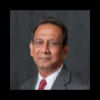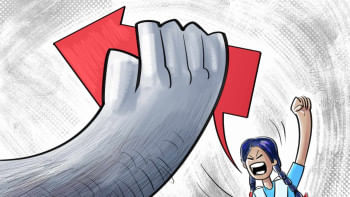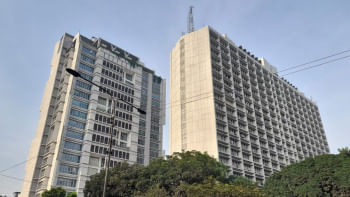Dhaka University’s ‘game of departments’

People who are hypersensitive about Dhaka University's glorious past would rather not accept that it is the Ordinance of 1973 itself that has brought this so-called "Oxford of the East" to its current mess and malaise. The prevalent narrative is that everything at this institution prior to 1973 were attempts to maintain the government's control over the institution. One DU website entry characterises this milestone ordinance as when "democratic norms and autonomy became integral features of the institution." Yet, because of the adherence to rules and regulations during those first 50 or so years, there weren't many adverse effects on the academic aspects of this university or its faculty. Now, it is clearly a different story.
Democracy needs its voters; and in the case of Dhaka University, this meant recruiting enough of the right kind of voters, those willing to preserve its mediocrity and guarantee both political and financial control. If there are more students to serve, an institution may justifiably recruit more faculty members by making sure the overall student-to-faculty ratio remains invariant. The faculty recruitment strategy used at DU, thanks to the ordinance, was unusual and agenda-driven. The number of students increased from 22,500 in 2000 to 37,018 today, a 64 percent increase. Yet, the number of faculty members doubled to 1,992. During the eight-year tenure of one former vice-chancellor, at least 78 of the 907 recruited faculty members did not meet the minimum qualifications. Globally ranked universities do increase the number of faculty members to meet the teaching needs of a larger student body, but without increasing the number of departments and associated bureaucracy. When these institutions recruit new faculty members, they view this as an opportunity to bring in only those talents who will bolster the institution's reputation.
The surge of faculty members at DU has resulted in offices and corridors that are often devoid of faculty members since a large number of them are busy teaching at private universities. The ordinance has allowed DU to create evening programmes which are now run by 35 departments, involving 36.4 percent of the university's faculty members. Thus, those active in these two activities have little or no time left for either teaching or research.
Unlike in India, Malaysia, Pakistan, Thailand, and Singapore, public universities in Bangladesh have settled on a minimal set of criteria for promotion and recruitment. Even though the ordinance dates back to 1973, public universities waited 48 years (in the name of autonomy) before agreeing to adopt their rather trivial promotion criteria. Private universities, thanks to the University Grants Commission, settled on nearly the same promotion criteria but only in 23 years. This fact alone is why some of the better private universities in Bangladesh are beginning to get ahead of most public universities in global rankings.
To justify a 100 percent increase in the number of faculty members, DU created newer departments whether this made any academic sense or not. The university that began operations in 1921 with three faculties and 12 departments grew to have five faculties and 29 departments by 1973. By 2000, there were 47 departments. And now that number is 83, an increase of 186 percent since the Ordinance of 1973. Each new department means a new head and the possibility of someone becoming a head every few years. During the last two decades, the number of institutes has increased from nine to 13, and the number of research centres and bureaus increased from 16 to 56. It's clear that this increase in the number of institutes, research centres, and bureaus hasn't translated to an improvement in the university's research reputation, as evidenced by the latest global rankings.
What has been transpiring at public universities since 1973 has little or no academic rationale to support it, while students and their families have been the victims of uncertain futures. Much like George RR Martin's Game of Thrones, waged for control over the Seven Kingdoms of Westeros, the DU has also been playing a game of departments for decades.
The Physics wing of DU, established in 1921, gave birth to four offspring, two of which had positive impacts while the same cannot be said about the other two. Physics underwent a legitimate pre-1973 transition which resulted in the creation of Applied Physics in 1965. By 1974, post-ordinance, this unit had a name change and became Applied Physics and Electronics. By 2021, it had evolved to become Electrical and Electronic Engineering (now with 36 faculty members – 14 professors, five associate professors, eight assistant professors, and nine lecturers) and is now part of a booming Faculty of Engineering and Technology. Theoretical Physics was introduced in 1975, only to be folded in 1978 following the end of the first term of its first head. In globally ranked universities, Theoretical Physics is rarely a department in itself, unless it hosts a large number of researchers. But DU decided to revive its Theoretical Physics department in 2008 with a head for only three faculty members, including the head – one professor and two associate professors. The same year, another group diverged from Physics to create Biomedical Physics and Technology – with a head for six faculty members, including the head (one associate professor, two assistant professors, and two lecturers). Then, in 2011, Nuclear Engineering came out of Physics, and currently has 15 faculty members. Because of its appeal and what it can offer to its students, Nuclear Engineering has become a part of the Faculty of Engineering and Technology. Both Theoretical Physics and Biomedical Physics and Technology have remained anaemic and wouldn't have been created or revived if not for the 1973 ordinance. Additionally, Biomedical Physics and Technology isn't applied enough yet to become a part of the Faculty of Engineering and Technology, and thus, will need to continue being a part of the Faculty of Science.
Another play by DU involves Chemistry, which was established in 1921 and underwent a legitimate pre-1973 transition when a part of it became Pharmacy in 1964. Then, after 39 years, thanks to the ordinance, Pharmacy gave birth to triplets: Clinical Pharmacy and Pharmacology, currently having 25 faculty members; Pharmaceutical Chemistry, with 21 faculty members; and Pharmaceutical Technology, hosting 21 faculty members. The parent department was eliminated but was resuscitated in 2014 after a hiatus of 11 years. This revived department now has one person heading its two faculty members, including the head. The net result of this bizarre game of departments is a new Faculty of Pharmacy which now shelters four independent departments and four new heads.
An investigation of the different ongoing games of departments within the non-science and non-engineering departments of DU also reveals that, except in the rarest cases, the creation of new departments hardly ever reflected changes in the market, the knowledge base, or student demands. In the majority of these cases, the changes were results of considerations that had little or nothing to do with academic needs. Mass Communication and Journalism, which has existed since 1962, branched out into Television, Film, and Photography in 2012, and Printing and Publication Studies in 2015. Meanwhile, there has been overlap between the offerings of the parent department and those of Television, Film, and Photography. Similarly, a part of the Sanskrit and Pali department, which has roots going back to 1921, moved on to create Pali and Buddhist Studies in 2006.
Despite the frequent introduction of departments at Bangladesh's public universities, they altogether attracted only 767 international students in 2020. Twice as many international students typically join the country's private universities. The ordinance that guides the private institutions is thankfully free of this game of departments. Related to this, in 2022, according to Unesco, over 49,000 students left Bangladesh for destinations overseas, a large majority of whom may never return. This number was 22,905 in 2012 and 12,390 in 2002.
Mohammad A Karim is professor of electrical and computer engineering at the University of Massachusetts Dartmouth in Massachusetts, US.
Views expressed in this article are the author's own.
Follow The Daily Star Opinion on Facebook for the latest opinions, commentaries and analyses by experts and professionals. To contribute your article or letter to The Daily Star Opinion, see our guidelines for submission.

 For all latest news, follow The Daily Star's Google News channel.
For all latest news, follow The Daily Star's Google News channel. 











Comments